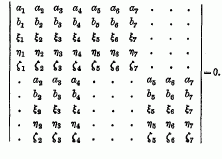No CrossRef data available.
Published online by Cambridge University Press: 15 September 2014
In Reiss we have an author who starts to his subject as if it were entirely new, the only preceding mathematician whom he mentions being Lagrange. Like Cauchy he opens by explaining a mode of forming functions more general than those of which he afterwards treats, the essence of it being that an expression involving several of the n.v quantities,

is taken, and each exponent (“exposant”) changed successively with all the other exponents, α, β, …, or each base changed with all the other bases, a, b,.… Only a line or two, however, is given to this, the special class known to us as determinants being taken up at once.
note * page 208 Or (abcde,12345), or indeed [a 1a 2…a n, 123… n).
note * page 214 In Reiss's notation the extension is AA BB … Rp.
note * page 215 It is perhaps a little more readily seen to be derivable from

note * page 220 Instead of following Minding's lengthy process, a mathematician of the present time would of course observe that the coefficients of A, B, C, D are the principal minors of M, and using Cauchy's theorem would at once reach the desired conclusion, viz., that the determinant of them = M3.